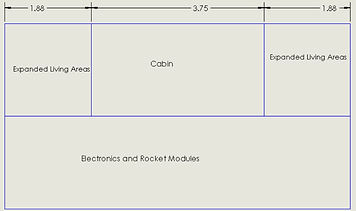

2028: The Great Return
CONceptual Designs
Concept 1
Retractable Landing Gear with Shock Absorption System
This concept consists of an adapted primary strut landing gear that was used in the Apollo missions. Since the lunar module could land at a variety of possible velocities, it is important that the shocks and struts on the module are capable of not only functioning in space, but are capable of repeatedly handling huge compressional loads.
A feasible solution would be to change the landing struts from the honeycomb design to a reusable electromechanical absorber, which was implemented in the Philae project. While this concept would add more weight to the system, its lifetime is considerably more advantageous for NASA as they continue to move to a model focused on reusability. The electromechanical shock absorber would function to absorb the kinetic energy upon impact and translate it into electrical energy.

Concept 2
Modular Radial Spacecraft Propulsion and Storage System
This concept consists of an external rail system to which various modules can slide and lock on to. This greatly extends the capabilities of the lander. Since it is reusable, it can be expected to last for several missions. Each mission is going to have different requirements and having a modular architecture allows for more flexibility. External attachments can allow for transport of large volume cargo which would be otherwise impossible to fit inside the lander. If the crew is transporting heavy cargo, they can attach additional radial engines to provide more thrust or external fuel tanks that can be jettisoned after being consumed. Having a standardized, modular rail system would allow commercial aerospace companies to add functionality to the lander by building their own modules or attachments.

Concept 3
Lunar Lander Expanding Habitat on Lunar Surface
The idea behind this concept is to maximize the amount of usable space within the craft while maintaining weight and costs down. There are many other similar concepts that have been tested out, but this concept will implement the use of the lander body as integral parts of the inflatable module. The use of the lander structure will provide great stability and slightly better shielding from radiation, as well as solid anchor points on which equipment can be safely harnessed to.
A crucial point of this design is the use of specific architecture to provide solid anchor points and provide an efficient shape for transportation.

Design Selection

The above concepts were all compared to one another to decide upon which would be the most advantageous to pursue for the purpose of the project. All topics were of relatively similar importance, but NASA guidelines influenced the weight of Reusability, Sustainability/Maintenance, and adaptability to be the three most important topics. The landing gear was ultimately selected, as it ended up scoring the highest in 6 of 8 criteria and scoring a total of 3.67 out of 5.

